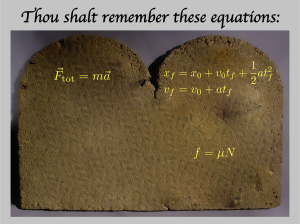26 Kinetic Friction
Friction is a “rubbing force:” when two objects slide against each other, they rub, generating a force that opposes the sliding. Let’s look at a simple example:
 Tom Cruise is sliding to the right. His feet are sliding on the floor going right, so the floor pushes back against that rub: friction points to the left, slowing him down and bringing him to a stop.
Tom Cruise is sliding to the right. His feet are sliding on the floor going right, so the floor pushes back against that rub: friction points to the left, slowing him down and bringing him to a stop.
Just as we invented a “theory of gravity” by arguing that the gravitational force is always given by ![]() , we now wish to invent a “theory of friction.” Our day-to-day experience provides two clues:
, we now wish to invent a “theory of friction.” Our day-to-day experience provides two clues:
-
- The strength of the force depends on the materials rubbing against each other (e.g. it’s hard to slide on rubber, but ice is slippery).
- If you squish objects into each other, it becomes harder to slide them past each other. That is, an increase in the normal force leads to an increase in the frictional force.
Exercise 26.1: The Law of Friction
Given all of the above, what is the simplest possible mathematical model for how the force of friction behaves?
Note this equation only tells us about the magnitude of the frictional force ![]() . The direction we need to determine on a case-by-case basis based on the following rule:
. The direction we need to determine on a case-by-case basis based on the following rule:
Friction always opposes “rubbing.”
That is, two rubbing objects will come to rest relative to each other, rather than start speeding up away from each other.
The coefficient ![]() that determines the force of friction between two objects is referred to as the frictional coefficient.
that determines the force of friction between two objects is referred to as the frictional coefficient.
Our newly proposed “law of friction”, ![]() , is remarkable. For instance, one might think that if the surface area between the two “rubbing” objects increases, there’d be more rubbing and therefore more friction. In practice, however, the impact of surface area on friction is small, and the simple model above works well (but perfectly!).
, is remarkable. For instance, one might think that if the surface area between the two “rubbing” objects increases, there’d be more rubbing and therefore more friction. In practice, however, the impact of surface area on friction is small, and the simple model above works well (but perfectly!).
There is one more subtle point that needs to be addressed here: our simple guess for a “theory of friction” (i.e. ![]() ) is only appropriate for objects that are actively rubbing on each other! This is easy to see.
) is only appropriate for objects that are actively rubbing on each other! This is easy to see.
Exercise 26.2: How much friction?
You place a book on a horizontal table.
Evidently, when a book is just sitting on a table doing noting, there is no frictional force, and therefore ![]() in this case.
in this case.
Because our law of friction ![]() is only valid for objets that are actively rubbing against each other, we refer to it as kinetic friction, and we place a “k” subscript in the frictional coefficient
is only valid for objets that are actively rubbing against each other, we refer to it as kinetic friction, and we place a “k” subscript in the frictional coefficient ![]() . With this understanding, we now assert that this is how friction works, and promote it to a law of physics. As such, it goes in our tablets!
. With this understanding, we now assert that this is how friction works, and promote it to a law of physics. As such, it goes in our tablets!

I did not include the “k” subscript in the equation for reasons that will become apparent in the next chapter.
Let’s try solving some problems involving friction.
Exercise 26.3: Beer Slide
You slide a beer down a bar. The kinetic frictional coefficient between the glass and the bar is
The kinetic frictional coefficient between the glass and the bar is ![]() , and you want the beer to slide a distance
, and you want the beer to slide a distance ![]() . What initial speed
. What initial speed ![]() should you impart on the beer glass for you to achieve your goal?
should you impart on the beer glass for you to achieve your goal?
Since this is our first problem involving friction, we’ll go through it slowly.
Step 1: Draw a picture. Make sure your drawing includes all of the forces acting on the beer while the story is taking place. For specificity, let’s say the beer is sliding to the right.
In the picture above, friction points left because to oppose the rubbing from the beer sliding to the right.
Now find relations and solve unknowns. As always, start with ![]() for each object, for each axis. Use this to find the beer’s acceleration.
for each object, for each axis. Use this to find the beer’s acceleration.
Now that you know the beer’s acceleration, use the kinematic equations to find what the initial speed of the beer should be.
Let’s try another problem.
Exercise 26.4: Sliding down a ramp
A box of mass ![]() is placed a distance
is placed a distance ![]() from the bottom of a ramp (see below). The ramp makes an angle
from the bottom of a ramp (see below). The ramp makes an angle ![]() with the horizontal, and the kinetic frictional coefficient between the ramp and the box is
with the horizontal, and the kinetic frictional coefficient between the ramp and the box is ![]() . The box slides down the ramp starting from rest. How fast will the box be traveling when it reaches the bottom of the ramp?
. The box slides down the ramp starting from rest. How fast will the box be traveling when it reaches the bottom of the ramp?
Let’s go through this problem slowly.
Now for a picture. In this problem the box moves in a line, but that line is neither horizontal nor vertical. Consequently, it is much more convenient to make our axis align with the motion of the box, as shown in the picture below. Try completing the picture by drawing forces and labeling things.
Notice how in the picture above gravity is not parallel to either the ![]() or
or ![]() axis. Consequently, we must decompose gravity into its components. This is also shown in the picture above. One thing that may not be obvious is why is the angle
axis. Consequently, we must decompose gravity into its components. This is also shown in the picture above. One thing that may not be obvious is why is the angle ![]() showing up when we split gravity into its components. If that’s unclear, see the video below.
showing up when we split gravity into its components. If that’s unclear, see the video below.
Now bring it home: find relations and solve unknowns.
- use Newton’s law for each axis to find the box’ acceleration
- use the kinetic equations to find the final velocity of the box.
I’ve split the solution in two: if you get stuck, watch the video to get you started, but then try to finish it up on your own.
To end, let me emphasize two important lessons you should draw from this problem:
-
- When objects move in a straight line, place your axis along that line.
- If a force is not along your axis, you must decompose into its components.
We will rely on these two lessons over and over throughout the rest of this book.
Key Takeaways
